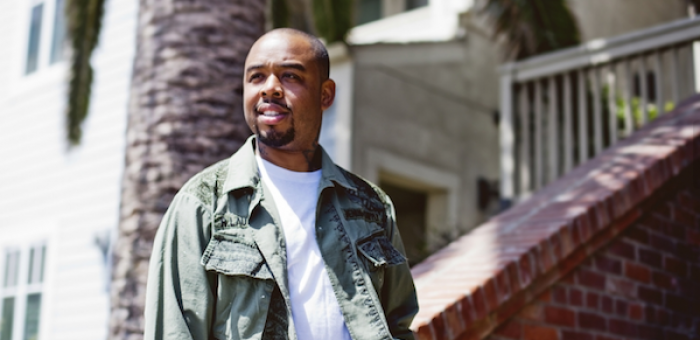Oct 28, 2025 10:47 AM
In Memoriam: Jack DeJohnette, 1942–2025
Jack DeJohnette, a bold and resourceful drummer and NEA Jazz Master who forged a unique vocabulary on the kit over his…

Terrance Martin released his sixth studio album, Velvet Portraits, in April on Ropeadope Records.
(Photo: Courtesy of the artist)That gives me a better sense how you came to play so many different instruments. What was your first musical instrument?
My first instrument was a Technics 1200 turntable. The second was an MPC. I didn’t play instruments at first. At one point, I wanted to be Jam Master Jay, especially when [Run-DMC’s 1986 song] “Peter Piper” first came out. And then when I started hearing Dr. Dre, I wanted to be Dre, Mixmaster Spade and DJ Battlecat. Then after that, I got into DJ Quik because he cut real fast! I mean, these were the pioneers of the turntable, so that was my first instrument. I practiced on that every day, eight or nine hours a day, from the time I was 8 or 9 years old.
Then I started producing when I was in like the sixth or seventh grade. My mother bought me a sampler. I had been seeing Dr. Dre at the swap meet where he was passing out NWA records. And I found out how he did beats, like he had an 808 drum machine. I heard the records and knew the records. The drum machine turned my life all the way around. Because of the drum machines, when I had to dig deeper into understanding hip-hop, I wanted to know how to do it. I had to start breaking the shit apart. I didn’t know that this was what my father was doing.
Fast forward, years of breaking this down, I hear A Tribe Called Quest and I’m like, “Damn, this music feels like the music my father used to play in the back of the house … that annoying shit every fuckin’ day called jazz!” [laughs]. He would come to my school and pick me up, and play John Coltrane loud as shit! It was embarrassing cause everyone else’s father played Too Short or Dana Dane or some New Edition cool shit! And here’s my dad playing Coltrane! [scats a Coltrane riff].
A Tribe Called Quest struck a chord because I’m digging it and find something [that makes me think], “What is this?” The song that made me play jazz music was “Sucka Nigga.” [from 1993’s Midnight Marauders]. … Reminded me of where I was from … .
I asked my dad, “Yo, what is that [sample]?” And he says, “That’s ‘Red Clay.’” Joe Henderson, Herbie Hancock, Lenny White, Ron Carter, Freddie Hubbard, CTI—that whole album is full of [jazz samples]. Before that, [my father] was just an old man who played old shit! So A Tribe Called Quest made me and my father have a better relationship.
Because of hip-hop, I learned how to dig. I didn’t dig deep in school. Hip-hop was the only thing that made me want to be intelligent, as a black man. So now I’m digging through different records from Joe Henderson, different records from Herbie Hancock … . When I went through his catalog, it evolved and it just got bigger and bigger. The concepts got bigger. When Herbie played music, it was jazzy but he played music that hit the black neighborhoods and made ’em dance. This music made people want to dance.
In the ghetto, nobody wants to hear that deep shit. We don’t have time to think about that shit; we’re trying to live and survive. We’re trying to dance and feel good. But if you ease it in, it’ll make somebody want to learn it.
Just like hip-hop, Herbie made me want to get in the water and understand jazz through his music. I found out who Miles Davis was through Herbie Hancock’s music. Through his music, I found out who Wynton Kelly was. Who Bill Evans was and McCoy Tyner was. I found out about other [jazz musicians] through his music. I mean, Herbie is a hip-hop musician. He’s a master to me. He probably would call himself a student. I wouldn’t.
For more info on Terrace Martin’s album Velvet Portraits, visit the Ropeadope Bandcamp web page. A few years ago, Martin posted a video on Vimeo, documenting his work on the 3ChordFold project. DB

Jack DeJohnette boasted a musical resume that was as long as it was fearsome.
Oct 28, 2025 10:47 AM
Jack DeJohnette, a bold and resourceful drummer and NEA Jazz Master who forged a unique vocabulary on the kit over his…

Goodwin was one of the most acclaimed, successful and influential jazz musicians of his generation.
Dec 9, 2025 12:28 PM
Gordon Goodwin, an award-winning saxophonist, pianist, bandleader, composer and arranger, died Dec. 8 in Los Angeles.…

Nov 13, 2025 10:00 AM
For results of DownBeat’s 90th Annual Readers Poll, complete with feature articles from our December 2025 issue,…

Flea has returned to his first instrument — the trumpet — and assembled a dream band of jazz musicians to record a new album.
Dec 2, 2025 2:01 AM
After a nearly five-decade career as one of his generation’s defining rock bassists, Flea has returned to his first…

To see the complete list of nominations for the 2026 Grammy Awards, go to grammy.com.
Nov 11, 2025 12:35 PM
The nominations for the 2026 Grammy Awards are in, with plenty to smile about for the worlds of jazz, blues and beyond.…








